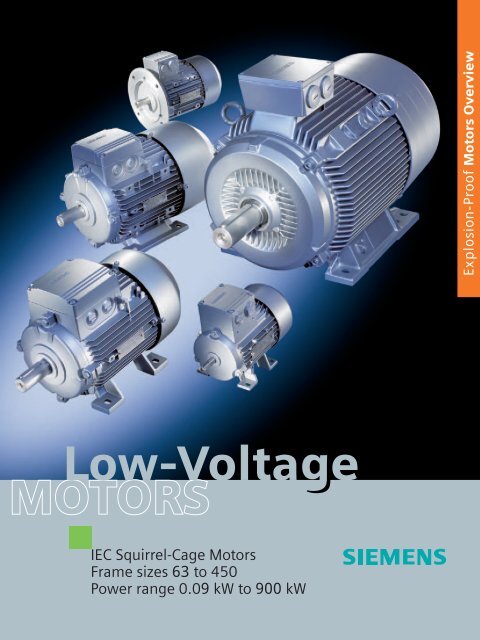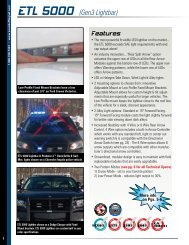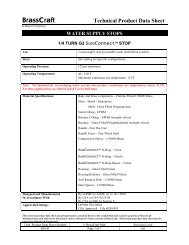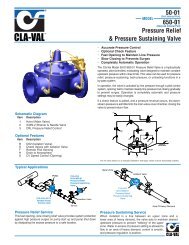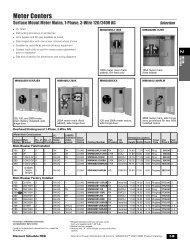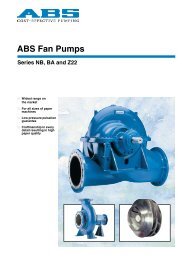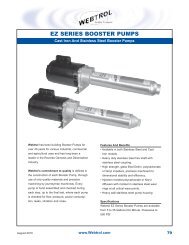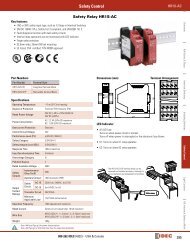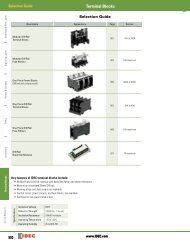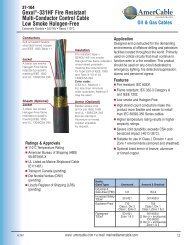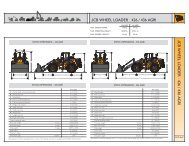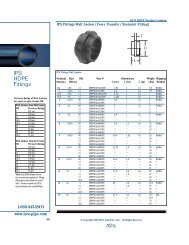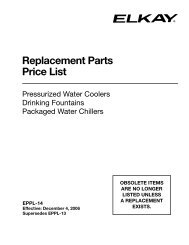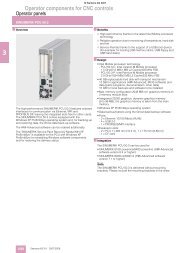Motors - Siemens
Motors - Siemens
Motors - Siemens
You also want an ePaper? Increase the reach of your titles
YUMPU automatically turns print PDFs into web optimized ePapers that Google loves.
Low-Voltage<br />
MOTORS<br />
IEC Squirrel-Cage <strong>Motors</strong><br />
Frame sizes 63 to 450<br />
Power range 0.09 kW to 900 kW<br />
Explosion-Proof <strong>Motors</strong> Overview
4<br />
IEC Squirrel-Cage <strong>Motors</strong><br />
Explosion-proof motors<br />
Orientation<br />
■ Overview<br />
In many industrial sectors as well as in domestic life, explosion<br />
protection or explosion hazards are ever-present, e.g. in the<br />
chemicals industry, in refineries, on drilling platforms, at petrol<br />
stations, in feed manufacturing and in sewage treatment plants.<br />
The risk of explosion is always present when gases, fumes, mist<br />
or dust are mixed with oxygen in the air in an explosive ratio<br />
close to sources of ignition that are able to release the so-called<br />
minimum ignition energy.<br />
Overview of explosion-proof motors<br />
Section Category<br />
4/2<br />
Zone Frequency<br />
of occurrence<br />
of the Ex<br />
atmosphere<br />
<strong>Siemens</strong> D 81.1 · 2006<br />
Degree of<br />
protection<br />
Temperature<br />
class<br />
Explosion-protected equipment are designed such that an<br />
explosion can be prevented when they are used properly.<br />
The explosion-protected equipment can be designed in accordance<br />
with various types of protection.<br />
The local conditions must be subdivided into specified zones by<br />
the user with the assistance of the responsible authorities in<br />
accordance with the frequency of occurrence of an explosion<br />
hazard. Device (equipment) categories are assigned to these<br />
zones. The zones are then subdivided into possible types of protection<br />
and therefore into possible equipment (product) types.<br />
Our product range contains motors in the following types of<br />
protection:<br />
"Increased safety" EEx e II<br />
"Explosion-proof enclosure" EEx de IIC/EEx d IIC<br />
"Non-sparking" Ex nA II/EEx nA II<br />
"Areas protected against dust explosions in Zones 21 and 22"<br />
The table below "Overview of explosion-proof motors" contains a<br />
complete overview of our products, their types of protection and<br />
the assignment of motor types to categories. It is important to<br />
note that depending on whether the motor is used for converterfed<br />
operation or mains-fed operation, different order codes are<br />
required for unique selection of the required product.<br />
Degree of<br />
protection<br />
Operation Standard Motor type<br />
(Pos. 1-4 of<br />
Order No.)<br />
Order<br />
code<br />
Utilisation<br />
according to<br />
temperature<br />
class<br />
Gas and 1G 0 Continuously or Not common practice with low-voltage motors<br />
steam (G)<br />
long-term<br />
2G 1 Infrequently EEx de IIC 1)<br />
T1 – T4 IP55 Mains IEC/EN 60 079-0 1MJ6/7 – B<br />
(explosion-proof<br />
enclosure)<br />
Converter IEC/EN 60 079-1 1MJ8/1 A15<br />
A16<br />
F<br />
EEx e II T1 – T3 IP55 Mains IEC/EN 60 079-0 1MA6<br />
– B/F<br />
(increased<br />
safety)<br />
IEC/EN 60 079-7 1MA7<br />
3G 2 Rarely or EEx nA II T1 – T3 IP55 Mains IEC/EN 60079-15 1LA6<br />
briefly<br />
Ex nA II<br />
(non sparking)<br />
1LA7<br />
1LA8, 1PQ8 2)<br />
M72 B<br />
Converter<br />
1LA9<br />
1LG4/6<br />
M73<br />
Dust (D) 1D 20 Continuously or Not common practice with low-voltage motors<br />
long-term<br />
2D 21 Infrequently Conductive dust Max. enclo- IP65 Mains EN 50281 1LA5<br />
suretemperature T<br />
125 °C<br />
1LA6<br />
1LA7<br />
1LA8 3) ,1PQ82) M34 B<br />
3D 22 Rarely or<br />
briefly<br />
Non-conductive<br />
dust<br />
IP55<br />
Converter<br />
Mains<br />
Converter<br />
1LA9<br />
1LG4/6<br />
M38<br />
M35<br />
M39<br />
1) Highest explosion group IIC includes IIB and IIA.<br />
2) 1PQ8 is not possible for Zone 21 and 22; Zone 2 for 1PQ8 available on<br />
request. Utilisation according to temperature class F.<br />
3) 1LA8 only available for Zone 22 (order codes M35, M39). Utilisation<br />
according to temperature class F.
■ Benefits<br />
The explosion-proof motors from <strong>Siemens</strong> offer the user numerous<br />
advantages:<br />
The motors are designed in accordance with Directive<br />
94/9/EU (ATEX 95 previously ATEX 100a). As product supplier,<br />
<strong>Siemens</strong> accepts responsibility for compliance with the applicable<br />
product standards for the selected equipment.<br />
By using this product, the plant operating company satisfies<br />
Directive 1999/92/EU in accordance with Appendix II B<br />
(ATEX 137 previously ATEX 118a). The plant manufacturer or<br />
plant operating company is responsible for correct selection<br />
and proper usage of the equipment.<br />
■ Application<br />
The explosion-proof motors are used in the following sectors to<br />
prevent explosion hazards that result in serious injury to persons<br />
and severe damage to property.<br />
Chemical and petrochemical industry<br />
Production of mineral oil and gas<br />
Gas works<br />
Gas supply companies<br />
■ Technical specifications<br />
Zone 1 with type of protection EEx e II Increased Safety "e"<br />
All 1MA motors are certified in type of protection EEx e II for<br />
temperature classes T1 to T3 at an ambient temperature from<br />
–20 to +40 °C and have an EU type test certificate according to<br />
Directive 94/9/EG (ATEX 95). Higher temperature classes are<br />
available on request.<br />
Explosion protection is achieved when the certified motor versions<br />
interact with a similarly certified motor protection switch.<br />
The motor protection switch is selected in accordance with the<br />
values certified for the motor for the starting current ratio IA/IN and the tE times, so that in the case of a locked rotor fault, the<br />
motor is isolated from the supply within the tE time. The tE times<br />
assigned to the separate temperature classes and the starting<br />
current ratio are marked on the rating plate.<br />
Explosion protection can be achieved exclusively by the PTC<br />
thermistors embedded in the winding provided that the motor<br />
has been specially approved and certified for this. This type of<br />
protection is not technically possible for every motor, so it is<br />
essential to enquire before ordering.<br />
With the exception of 2-pole motors of frame size 225 M and<br />
above, all motors are of an identical version, i.e. the motors can<br />
be operated at T1/T2 or T3 at the appropriate rated output. For<br />
special versions (different frequency, output, ambient temperature,<br />
site altitude, etc.) a new certificate is necessary (please<br />
enquire). The temperature class must be specified in the order,<br />
otherwise the universal version T1/T2 and T3 will be certified<br />
(doubling the certification costs).<br />
Identification on the rating plate:<br />
II 2G EEx e II T1 – T3<br />
IEC Squirrel-Cage <strong>Motors</strong><br />
Explosion-proof motors<br />
<strong>Siemens</strong> D 81.1 · 2006<br />
Orientation<br />
Comprehensive series of explosion-proof motors for protection<br />
against gas and dust.<br />
Individual versions of motors are possible thanks to the<br />
numerous catalogue options.<br />
Further special versions are possible on request.<br />
Certificates are available for a defined spectrum of <strong>Siemens</strong><br />
motors/converters.<br />
Petrol stations<br />
Coking plants<br />
Mills (e.g. corn, solids)<br />
Sewage treatment plants<br />
Wood processing (e.g. sawdust, tree resin)<br />
Other industries subject to explosion hazards<br />
Zone 1 with type of protection EEx de IIC explosion-proof<br />
enclosure "d"<br />
All 1MJ motors are certified for the highest explosion group IIC,<br />
temperature classes T1 to T4 at ambient temperatures from<br />
–20 to +60 °C and have an EC type test certificate according to<br />
Directive 94/9/EG (ATEX 95).<br />
These motors are designed such that an explosion within the<br />
casing cannot result in an explosion in the environment. The energy<br />
that is generated internally by an explosion is dissipated in<br />
the so-called "flameproof chamber" so far that the energy is no<br />
longer sufficient for ignition outside the casing. The casing temperature<br />
is below the ignition temperature of the gases to which<br />
temperature class T4 applies.<br />
The 1MJ6 motors (frame size 71 to 200) generally have a located<br />
bearing on the non-drive-end (NDE) of the motor.<br />
The following variations are possible on request:<br />
Coolant temperature >40 °C or site altitude >1000 m (for<br />
1MJ6, the reduction factors listed in the "Introduction" section<br />
of the catalogue under "General technical data", "Coolant temperature<br />
and site altitude" are applicable).<br />
Frequency and rated duty<br />
Pole-changing motors<br />
Insulated bearing at the non-drive-end (NDE)<br />
Use according to temperature class F in mains-fed operation<br />
On the frequency converter, motors in type of protection<br />
"explosion-proof enclosure" can be used thermally acc. to temperature<br />
class F. Converter-fed operation can be ordered with<br />
order code A15 (PTC thermistors for tripping) or A16 (PTC thermistors<br />
for tripping and alarm), whereby an additional PTC thermistor<br />
is fitted to 1MJ6/1MJ7 motors in the connection box.<br />
Identification on the rating plate:<br />
or<br />
II 2G EEx de IIC T1 – T4<br />
II 2G EEx d IIC T1 – T4<br />
4/3<br />
4
4<br />
IEC Squirrel-Cage <strong>Motors</strong><br />
Explosion-proof motors<br />
Orientation<br />
■ Technical specifications (continued)<br />
Zone 2 with type of protection EEx nA/Ex nA (non-sparking)<br />
Zone 2 acc. to IEC/EN 60079-15<br />
The duty types are:<br />
- Design for Zone 2 for mains-fed operation (order code M72)<br />
- Design for Zone 2 for mains-fed operation, with derating<br />
(order code M73)<br />
1LA/1LG motors are modified for this purpose in the<br />
"Non-sparking" design and are suitable for use in hazardous<br />
areas of Zone 2 for temperature classes T1 to T3. The maximum<br />
surface temperature that can occur during operation must lie<br />
below the limit temperature of the respective temperature class.<br />
The ventilation system must be in accordance with<br />
DIN EN 50014. An external earthing terminal is fitted to the<br />
motors. The connection box is similar to the EExe design.<br />
Please enquire in the case of<br />
Use in accordance with temperature class F<br />
For pole-changing versions<br />
For motors in the "Non-sparking" version, a conformity declaration<br />
is available from a recognised testing authority.<br />
Ambient temperature –20 to +60 °C, whereby derating applies<br />
from 40 °C upwards. Other temperatures are available on request.<br />
The rating plate or the extra rating plate contains the text:<br />
Ex nA II T3 II 3G EEx nA II T3<br />
IEC/EN 60079-15 and number of the "Conformity declaration"<br />
The motors do not have a rated voltage range stamped on the<br />
rating plate.<br />
Protection against dust explosions in Zones 21 and 22<br />
The distinction between Zones 21 and 22 is as follows:<br />
Zone 21 according to IEC 61241, EN 50281 1)<br />
Zone 22 according to IEC 61241, EN 50281<br />
- Design for Zone 22 for non-conducting dust (IP55) for mainsfed<br />
operation (order code M35)<br />
- Design for Zone 22 for non-conducting dust (IP55) for<br />
converter-fed operation, derating (order code M39)<br />
The 1LA/1LG motors are modified for this purpose for use in<br />
zones subject to dust explosion hazards. The surface temperature<br />
is ˆ125 °C at rated duty.<br />
An external earthing terminal and an external metal fan are fitted<br />
to the motors. In the design for Zone 21, the connection box is<br />
similar to the EExe design.<br />
Pole-changing versions are not possible for Zone 21 – they are<br />
possible for Zone 22 on request.<br />
Certification:<br />
Zone 21: EC type-test certificate (ATEX), issued by the DMT<br />
testing authority (Deutsche Montan-Technologie) and EC<br />
declaration of conformity.<br />
Zone 22: EC declaration of conformity<br />
Identification on the rating plate:<br />
Zone 21: II 2D T125 °C<br />
Zone 22: II 3D T125 °C<br />
Ambient temperature –20 °C to +60 °C, whereby derating applies<br />
from 40 °C upwards. Other temperatures are available on request.<br />
Generally, the following is valid:<br />
All Ex motors in vertical type of construction with shaft extension<br />
pointing down must have a protective cover.<br />
Ex motors cannot be designed in accordance with UL and CSA.<br />
The certificates for the motors for hazardous areas are stored<br />
- Design for Zone 21, as well as Zone 22 for conducting dust<br />
(IP65) for mains-fed operation (order code M34)<br />
- Design for Zone 21, as well as Zone 22 for conducting dust<br />
(IP65) for converter-fed operation, derating (order code M38<br />
Overview of the technical specifications<br />
Explosion-proof motors - The technology at a glance<br />
with the documentation in the SD configurator tool for low-voltage<br />
motors.<br />
For converter-fed operation, Ex motors must always be monitored<br />
using PTC thermistors. Certified tripping units are required<br />
for this purpose, see Catalog LV1.<br />
Comprehensive operating instructions and the declaration of<br />
conformity are supplied with Ex motors.<br />
In the case of non-standard 1LA8 and 1PQ8 motors, the bearing<br />
temperature must be monitored (order code A72).<br />
<strong>Motors</strong> Type of protection "e" Type of protection "d" Type of protection "n" Dust explosion protection<br />
Frame size 63 M ... 315 L 71 M ... 450 63 M ... 450 56 M ... 450 L<br />
Output range 0.12 to 160 kW 0.25 to 950 kW 0.09 to 1000 kW 0.06 to 1000 kW<br />
Number of poles 2/4/6 2/4/6/8 2/4/6/8 2/4/6/8<br />
Temperature class T1 - T3 T1 - T4 T3 –<br />
Degree of protection II 2 G EEx e II acc. to<br />
IEC/EN 60079-0<br />
IEC/EN 60079-7<br />
4/4<br />
<strong>Siemens</strong> D 81.1 · 2006<br />
II 2 G EEx de II acc. to<br />
IEC/EN 60079-0<br />
IEC/EN 60079-1<br />
Ex nA<br />
II 3 G EEx nA acc. to<br />
IEC/EN 60079-15<br />
Zone 21: II 2D IP 65 T 125 °C 2)<br />
Zone 22: II 3D IP 55 T 125 °C<br />
acc. to EN 50281/IEC 61241<br />
Directive 94/9/EG, ATEX 95 94/9/EG, ATEX 95 94/9/EG, ATEX 95 94/9/EG, ATEX 95<br />
Protection class IP55 IP55 IP55 Zone 21: IP65<br />
Zone 22: IP55<br />
Voltages All commonly used voltages All commonly used voltages All commonly used voltages All commonly used voltages<br />
Frequency 50 and 60 Hz 50 and 60 Hz 50 and 60 Hz 50 and 60 Hz<br />
Type of construction All common types of<br />
construction<br />
Casing FS 63 M ... 160 L aluminium<br />
FS100L...315Lcast-iron<br />
All common types of<br />
construction<br />
FS 71 M ... 315 L cast-iron<br />
FS 355 ... 450 steel<br />
All common types of<br />
construction<br />
FS 63 M ... 160 L aluminium<br />
FS 100 L ... 450 cast-iron<br />
All common types of<br />
construction<br />
FS 56 M ... 225 M aluminium<br />
FS 100 L ... 450 1) cast-iron<br />
Cooling method Surface-cooled Surface-cooled Surface-cooled Surface-cooled<br />
Temperature class F used acc. to B F used acc. to B F used acc. to B F used acc. to B 3)<br />
Insulation system DURIGNIT IR 2000 DURIGNIT IR 2000,<br />
converter-compatible up to 500 V,<br />
690 V on request<br />
1) Zone 21 only up to frame size 315 L<br />
2) Zone 21 for “Non-standard motors frame size 315 and above” only up to<br />
frame size 315 possible.<br />
DURIGNIT IR 2000,<br />
converter-compatible up to 500 V,<br />
690 V on request<br />
DURIGNIT IR 2000,<br />
converter-compatible up to 500 V,<br />
690 V on request<br />
3) For “Non-standard motors frame size 315 and above” temperature class F<br />
utilized according to F.
IEC Squirrel-Cage <strong>Motors</strong><br />
Explosion-proof motors<br />
<strong>Siemens</strong> D 81.1 · 2006<br />
Orientation<br />
■ Selection and ordering data<br />
Preliminary selection of the motor according to motor type/series, speed or number of poles, frame size, rated output, rated<br />
torque, rated speed and rated current<br />
Self-ventilated motors in Zone 1 with type of protection "e" (EEx e II Increased safety)<br />
Speed Frame size Rated output Rated speed Rated<br />
torque<br />
Rated current<br />
at 400 V<br />
rpm kW rpm Nm A<br />
Aluminium series 1MA7 50 Hz<br />
3000, 2-pole 63 M ... 160 L 0.18 ... 16 2810 ... 2910 0.61 ... 53 0.55 ... 30.0 4/12 ... 4/13<br />
1500, 4-pole 63 M ... 160 L 0.12 ... 13.5 1375 ... 1465 0.83 ... 88 0.52 ... 27 4/14 ... 4/15<br />
1000, 6-pole 71 M ... 160 L 0.25 ... 9.7 850 ... 965 2.8 ... 96 0.81 ... 21 4/14 ... 4/15<br />
Cast-iron series 1MA6 50 Hz<br />
3000, 2-pole 100 L ... 315 L 2.5 ... 165 2865 ... 2986 8.3 ... 528 5.3 ... 280 4/16 ... 4/19<br />
1500, 4-pole 100 L ... 315 L 2 ... 165 1420 ... 1492 14 ... 1061 4.5 ... 305 4/20 ... 4/23<br />
1000, 6-pole 100 L ... 315 L 1.3 ... 135 935 ... 991 13 ... 1300 3.35 ... 240 4/24 ... 4/27<br />
Self-ventilated motors in Zone 1 with type of protection "d" (EEx de IIC explosion-proof enclosure)<br />
Speed Frame size Rated output Rated speed Rated<br />
torque<br />
Rated current<br />
at 400 V<br />
rpm kW rpm Nm A<br />
Cast-iron series 1MJ6 50 Hz<br />
3000, 2-pole 71 M ... 200 L 0.37 ... 37 2750 ... 2945 1 ... 120 0.98 ... 64 4/28 ... 4/29<br />
1500, 4-pole 71 M ... 200 L 0.25 ... 30 1325 ... 1465 1 ... 196 0.78 ... 55 4/30 ... 4/31<br />
1000, 6-pole 71 M ... 200 L 0.25 ... 22 870 ... 75 2 ... 215 0.82 ... 42.5 4/32 ... 4/33<br />
750, 8-pole 90 L ... 200 L 0.37 ... 15 655 ... 725 5 ... 198 1.16 ... 32 4/34 ... 4/35<br />
Cast-iron series 1MJ7 50 Hz<br />
3000, 2-pole 225 M ... 315 M 45 ... 132 2955 ... 2980 145 ... 423 77 ... 225 4/28 ... 4/29<br />
1500, 4-pole 225 S ... 315 M 37 ... 132 1475 ... 1486 240 ... 848 67 ... 232 4/30 ... 4/31<br />
1000, 6-pole 225 M ... 315 M 30 ... 90 978 ... 988 293 ... 870 56 ... 162 4/32 ... 4/33<br />
750, 8-pole 225 S ... 315 M 18.5 ... 75 725 ... 738 244 ... 970 37.5 ... 140 4/34 ... 4/35<br />
Steel series 1MJ8 50 Hz<br />
3000, 2-pole 355 315 ... 400 2982 ... 2985 1009 ... 1279 530 ... 655 4/36 ... 4/37<br />
1500, 4-pole 355 280 ... 400 1485 ... 1491 1795 ... 2561 495 ... 690 4/36 ... 4/37<br />
1000, 6-pole 355 250 ... 315 993 ... 994 2403 ... 3027 440 ... 560 4/38 ... 4/39<br />
750, 8-pole 355 200 ... 250 744 2566 ... 3206 370 ... 466 4/38 ... 4/39<br />
Steel/cast-iron series 1MJ1 50 Hz<br />
3000, 2-pole 315 M ... 450 160 ... 900 2977 ... 2985 515 ... 2879 280 ... 915 4/36 ... 4/37<br />
1500, 4-pole 315 M ... 450 160 ... 950 1485 ... 1493 1030 ... 6076 285 ... 1355 4/36 ... 4/37<br />
1000, 6-pole 315 M ... 450 110 ... 800 990 ... 995 1060 ... 7676 195 ... 1240 4/38 ... 4/39<br />
750, 8-pole 315 M ... 450 90 ... 670 740 ... 746 1160 ... 8579 175 ... 1210 4/38 ... 4/39<br />
Detailed<br />
selection and ordering data<br />
Page<br />
Detailed<br />
selection and ordering data<br />
Page<br />
4/5<br />
4
4<br />
IEC Squirrel-Cage <strong>Motors</strong><br />
Explosion-proof motors<br />
Orientation<br />
■ Selection and ordering data (continued)<br />
Self-ventilated motors in Zones 2, 21 and 22 with type of protection "n" or protection against dust explosions<br />
Speed Frame size Rated output Rated speed Rated<br />
torque<br />
<strong>Motors</strong> for converter-fed operation 1LA8 3) with normal and<br />
special insulation or 1PQ8 3) , for special insulation, see overview<br />
on page 3/7.<br />
4/6<br />
<strong>Siemens</strong> D 81.1 · 2006<br />
Rated current<br />
at 400 V, 50 Hz<br />
at 460 V, 60 Hz<br />
rpm<br />
kW at 50 Hz<br />
HP at 60 Hz rpm Nm A<br />
Aluminium series 1LA7 and 1LA5 1) 50 Hz<br />
3000, 2-pole 56 M 2) ... 225 M 0.09 ... 45 2830 ... 2959 0.3 ... 145 0.26 ... 78 4/40 ... 4/41<br />
1500, 4-pole 56 M 2) ... 225 M 0.06 ... 45 1350 ... 1470 0.42 ... 292 0.2 ... 80 4/42 ... 4/43<br />
1000, 6-pole 63 M ... 225 M 0.09 ... 30 850 ... 978 1 ... 293 0.44 ... 61 4/44 ... 4/45<br />
750, 8-pole 71 M ... 225 M 0.09 ... 22 630 ... 724 1.4 ... 290 0.36 ... 44.5 4/46 ... 4/47<br />
Aluminium series 1LA9<br />
"High Efficiency" 50 Hz<br />
3000, 2-pole 56 M ... 200 L 0.09 ... 37 2830 ... 2950 0.3 ... 120 0.24 ... 64 4/48 ... 4/49<br />
1500, 4-pole 56 M ... 200 L 0.06 ... 30 1380 ... 1465 0.42 ... 196 0.22 ... 53 4/50 ... 4/51<br />
1000, 6-pole 90 S ... 200 L 0.75 ... 22 925 ... 975 7.7 ... 215 2 ... 45 4/52 ... 4/53<br />
For implementation in the North American market according to EPACT 60 Hz<br />
3600, 2-pole 56 M ... 200 L 0.12 ... 50 3440 ... 3555 0.25 ... 100 0.23 ... 57 4/54 ... 4/55<br />
1800, 4-pole 56 M ... 200 L 0.08 ... 40 1715 ... 1770 0.33 ... 161 0.18 ... 47 4/56 ... 4/57<br />
1200, 6-pole 90 S ... 200 L 1 ... 30 1140 ... 1175 6.2 ... 182 1.78 ... 40 4/58 ... 4/59<br />
Cast-iron series 1LA6 and 1LG4 50 Hz<br />
3000, 2-pole 100 L ... 315 L 3 ... 200 2890 ... 2982 9.9 ... 641 6.1 ... 325 4/60 ... 4/61<br />
1500, 4-pole 100 L ... 315 L 2.2 ... 200 1420 ... 1486 15 ... 1285 4.7 ... 340 4/62 ... 4/63<br />
1000, 6-pole 100 L ... 315 L 1.5 ... 160 925 ... 988 15 ... 1547 3.9 ... 285 4/64 ... 4/65<br />
750, 8-pole 100 L ... 315 L 0.75 ... 132 679 ... 738 11 ... 1708 2.15 ... 245 4/66 ... 4/67<br />
Cast-iron series 1LG6<br />
"High Efficiency" 50 Hz<br />
3000, 2-pole 180 M ... 315 L 22 ... 200 2955 ... 2982 71 ... 641 38.5 ... 320 4/68 ... 4/69<br />
1500, 4-pole 180 M ... 315 L 18.5 ... 200 1470 ... 1490 120 ... 1282 34.5 ... 340 4/68 ... 4/69<br />
1000, 6-pole 180 M ... 315 L 15 ... 160 975 ... 990 147 ... 1543 29.5 ... 280 4/70 ... 4/71<br />
750, 8-pole 180 M ... 315 L 11 ... 132 725 ... 740 145 ... 1704 23.5 ... 240 4/70 ... 4/71<br />
For implementation in the North American market according to EPACT 60 Hz<br />
3600, 2-pole 180 M ... 315 L 30 ... 300 3560 ... 3591 60 ... 595 34 ... 320 4/72 ... 4/73<br />
1800, 4-pole 180 M ... 315 L 25 ... 300 1775 ... 1792 100 ... 1193 31 ... 335 4/74 ... 4/75<br />
1200, 6-pole 180 M ... 315 L 20 ... 200 1178 ... 1192 121 ... 1195 25.5 ... 235 4/76 ... 4/77<br />
Cast-iron series 1LA8 50 Hz for mains-fed operation 3)<br />
3000, 2-pole 315 ... 450 250 ... 1000 2979 ... 2986 801 ... 3200 415 ... 1020 3/10 ... 3/11<br />
1500, 4-pole 315 ... 450 250 ... 1000 1488 ... 1492 1600 ... 6400 430 ... 1060 3/10 ... 3/11<br />
1000, 6-pole 315 ... 450 200 ... 800 988 ... 993 1930 ... 7690 345 ... 1100 3/12 ... 3/13<br />
750, 8-pole 315 ... 450 160 ... 630 739 ... 744 2070 ... 8090 295 ... 1160 3/12 ... 3/13<br />
Cast-iron series 1PQ8 50 Hz with standard insulation ˆ500 V 3)<br />
3000, 2-pole 315 ... 450 250 ... 1000 2979 ... 2986 801 ... 3200 415 ... 1020 3/22 ... 3/23<br />
1500, 4-pole 315 ... 450 250 ... 1000 1488 ... 1492 1600 ... 6400 430 ... 1060 3/22 ... 3/23<br />
1000, 6-pole 315 ... 450 200 ... 800 988 ... 993 1930 ... 7690 345 ... 1100 3/24 ... 3/25<br />
750, 8-pole 315 ... 450 160 ... 630 739 ... 744 2070 ... 8090 295 ... 1160 3/24 ... 3/25<br />
1) Motor series 1LA5 is not possible for Zone 2.<br />
2) Motor series 1LA7 is only possible for Zone 2 in frame size 63 M and<br />
above.<br />
3) Motor series 1LA8 and 1PQ8 are not possible for Zone 21, 1PQ8 for<br />
Zone 2 & 22 on request.<br />
Detailed<br />
selection and ordering data<br />
Page
■ More information<br />
Fundamental physical principles and definitions<br />
Explosion<br />
An explosion is the sudden chemical reaction of a combustible<br />
substance with oxygen, involving the release of high energy.<br />
Combustible substances can be gases, vapours, steam or dust.<br />
An explosion can only take place if the following three factors<br />
coincide:<br />
1. Combustible substance (in the relevant distribution and concentration)<br />
2. Oxygen (in the air)<br />
3. Source of ignition (e.g. electrical spark)<br />
Primary and secondary explosion protection<br />
Integrated explosion protection<br />
1. Prevention of dangerous potentially explosive atmospheres<br />
2. Prevention of the ignition of dangerous potentially explosive<br />
atmospheres<br />
3. Limiting the explosion to a negligible degree<br />
The principle of integrated explosion protection requires all explosion<br />
protection measures to be carried out in a defined order.<br />
A distinction is made here between primary and secondary protective<br />
measures.<br />
Primary explosion protection covers all measures that prevent<br />
the formation of a potentially explosive atmosphere.<br />
What are the protective measures that can be taken to minimise<br />
the risk of an explosion?<br />
Avoidance of combustible substances<br />
Inerting (addition of nitrogen, carbon dioxide, etc.)<br />
Limiting of the concentration<br />
Improved ventilation<br />
Secondary explosion protection is required if the explosion<br />
hazard cannot be removed or can only be partially removed<br />
using primary explosion protection measures.<br />
When considering safety-related factors, it is necessary to know<br />
certain characteristic quantities of combustible materials.<br />
Flash point<br />
The flash point for flammable liquids specifies the lowest temperature<br />
at which a vapor-air mixture forms over the surface of<br />
the liquid that can be ignited by a separate source.<br />
If the flash point of such a flammable liquid is significantly above<br />
the maximum occurring temperatures, a potentially explosive<br />
atmosphere cannot form there. However, the flash point of a<br />
mixture of different liquids can also be lower than the flash point<br />
of the individual components.<br />
In technical regulations, flammable liquids are divided into four<br />
hazard classes:<br />
Hazard class Flash point<br />
AI 55 ... 100 °C<br />
B
4<br />
IEC Squirrel-Cage <strong>Motors</strong><br />
Explosion-proof motors<br />
Orientation<br />
■ More information (continued)<br />
In coal mines, methane gas explosions often caused coal dust<br />
explosions which surpassed the gas explosions in their effects.<br />
The risk of an explosion is prevented by using explosion-proof<br />
equipment in accordance with its protection capability. The identification<br />
of the equipment categories mirrors the effectiveness of<br />
the explosion protection and therefore its use in the corresponding<br />
areas subject to explosion hazard.<br />
The potential risk of explosive dust atmospheres and the selection<br />
of appropriate protective measures are assessed on the basis<br />
of safety characteristics for the materials involved. Dusts are<br />
subdivided here in accordance with two of their material-specific<br />
characteristics:<br />
Conductivity<br />
Dusts that have a specific electrical resistance of up to<br />
10 3 Wm are classed as conductive.<br />
Combustibility<br />
Combustible dusts, however, are characterised by the fact<br />
that they can burn or glow in air and that they can form explosive<br />
mixtures at atmospheric pressure and at temperature<br />
from –20 to +60 °C in combination with air.<br />
Examples of safety characteristics in the case of disturbed dust<br />
include the minimum ignition energy and the ignition temperature,<br />
whereas in the case of dust deposits, the glowing temperature<br />
is a characteristic feature.<br />
Minimum ignition energy<br />
The application of a certain amount of energy is required to<br />
ignite a potentially explosive atmosphere.<br />
The minimum energy is taken to be the lowest possible converted<br />
energy, for example, the discharge of a capacitor, that will<br />
ignite the relevant flammable mixture.<br />
The minimum energy lies between approximately 10 -5 J for<br />
hydrogen, and several Joules for certain dusts.<br />
Selection of important EU directives<br />
4/8<br />
<strong>Siemens</strong> D 81.1 · 2006<br />
What can cause ignition?<br />
Hot surfaces<br />
Adiabatic compression<br />
Ultrasound<br />
Ionized radiation<br />
Open flames<br />
Chemical reaction<br />
Optical radiation<br />
Electromagnetic radiation<br />
Electrostatic discharge<br />
Sparks caused mechanically by friction or impact<br />
Electrical sparks and arcing<br />
Ionized radiation<br />
Legislative basis and standards<br />
Legislative basis of explosion protection<br />
Globally, explosion protection is regulated by the legislatures of<br />
the individual countries. At the international level, the IEC is attempting<br />
to get closer to the aim of "a single global test and certificate"<br />
by introducing the IECEx Scheme.<br />
EU directives<br />
In the European Union, explosion protection is regulated by<br />
directives and laws.<br />
Electrical equipment for use in potentially explosive atmospheres<br />
must therefore possess test certification or approval.<br />
The relevant systems and equipment are graded as systems<br />
requiring monitoring and must only use devices approved for<br />
this purpose. In addition, commissioning, modification, and<br />
regular safety inspections must only be accepted or carried<br />
out by approved institutions or societies. The EU directives are<br />
binding for all Member States and form the legal framework.<br />
Short designation Full text Directive no. Valid as of: End of<br />
transition period<br />
EX Directive (ATEX 95) Directive of the European Parliament and Council of March 23,<br />
1994 on the harmonization of laws of the Member States concerning<br />
equipment and protective systems intended for use in potentially<br />
explosive atmospheres<br />
94/9/EG 01.03.96 30.06.03<br />
ATEX 137 Minimum regulations for improving the health protection and safety 1999/92/EG<br />
of employees that could be endangered by potentially explosive<br />
atmospheres<br />
16.12.99 30.06.03
■ More information (continued)<br />
National laws and regulations<br />
In general, the EU directives are European laws that must be<br />
incorporated by the individual member states unmodified by<br />
ratification. Directive 94/9/EU was adopted completely into the<br />
German explosion protection regulation ExVO. The underlying<br />
legislation for technical equipment is the Equipment Safety Law<br />
(GSG) to which ExVO is appended as a separate regulation<br />
(11th. GSGV).<br />
In contrast, ATEX 137 (Directive - 1999/92/EC) contains only<br />
"Minimum regulations for improving the health protection and<br />
safety of employees that could be endangered by potentially explosive<br />
atmospheres", so that each EU member state can pass<br />
its own regulations beyond the minimum requirements. In the<br />
German Federal Republic, the contents of the directive have<br />
been implemented in factory safety legislation. In order to simplify<br />
the legislation, the contents of several earlier regulations<br />
have been simultaneously integrated into the factory safety<br />
legislation (’BetrSichVO’). From the area of explosion protection,<br />
these are:<br />
The regulation concerning electrical installations in potentially<br />
explosive atmospheres (ElexV)<br />
The acetylene regulation<br />
The regulation concerning flammable liquids<br />
These regulations became defunct when the factory<br />
safety legislation came into force on 01.01.2003.<br />
Explosion protection guidelines (EX-RL) of the professional<br />
associations<br />
In the "Guidelines for the prevention of hazards from potentially<br />
explosive atmospheres with listed examples" of the German<br />
Chemicals Professional Association, specific information is<br />
given on the hazards of potentially explosive atmospheres, and<br />
measures for their prevention or limitation are listed. Of special<br />
use are the examples of individual potentially explosive process<br />
plants in the most diverse industrial sectors in which these measures<br />
are listed in detail. Valuable suggestions and risk evaluations<br />
are available for planners and operators of such plants or<br />
similar process plants. While the EX Directives have no legal status,<br />
they are nevertheless to be regarded as important recommendations<br />
that can also be called upon for support in deciding<br />
legal questions in the event of damage.<br />
Standards<br />
There are a host of technical standards worldwide for the area of<br />
explosion protection. The standards environment is subject to<br />
constant modification. This is the result both of adaptation to<br />
technical progress and of increased safety demands in society.<br />
International efforts towards harmonisation also contribute, with<br />
the aim of achieving the most uniform global standards possible<br />
and the resulting removal of barriers to trade.<br />
EU standards<br />
The standards for explosion protection valid in the European<br />
Union are created on the basis of the EU Directives under the<br />
leadership of CENELEC (European Committee for Electrotechnical<br />
Standardisation). CENELEC comprises the national committees<br />
of the member states. Since, in the meantime, standardisation<br />
at international level gained greatly in importance through<br />
the dynamism of the IEC (International Electrotechnical Commission),<br />
CENELEC has decided only to pass standards in parallel<br />
with the IEC. In practice, this means European standards in the<br />
area of electrical/electronic systems will now be created or redefined<br />
almost exclusively on the basis of IEC standards as harmonized<br />
EN standards. For the area of explosion protection, these<br />
are mainly the standards of the EN 60079 series. The numbers<br />
of harmonised European standards are built up according to the<br />
following system:<br />
IEC<br />
IEC Squirrel-Cage <strong>Motors</strong><br />
Explosion-proof motors<br />
<strong>Siemens</strong> D 81.1 · 2006<br />
Orientation<br />
IEC/EN 60079-0 : 1997 Meaning<br />
Year of issue<br />
Number of standard<br />
Harmonized European Standard<br />
At the international level, the IEC (International Electrotechnical<br />
Commission) issues standards for explosion protection. The<br />
Technical Committee TC31 is responsible. Standards for explosion<br />
protection are found in the IEC 60079-x series (previously<br />
IEC 79-x). The x represents the numbers of the individual technical<br />
standards, e.g. IEC 60079-7 for intrinsic safety.<br />
Classification of explosion-protected equipment<br />
Identification<br />
The identification of electrical equipment for areas protected<br />
against explosion hazards should include:<br />
The manufacturer who supplied the equipment<br />
A designation that identifies it<br />
The implementation range<br />
- In underground mines I<br />
- Other areas II<br />
- Gases and vapours - G -, dusts - D - or mines - M -,<br />
The categories that specify whether the device can be used<br />
for specific zones<br />
The type(s) of protection to which the equipment complies<br />
The testing authority that issued the test certificate, the standard<br />
or version of the standard to which the equipment complies<br />
– including the registration number of the certificate from<br />
the testing authority, and if necessary, the special conditions<br />
to be observed.<br />
The data that is normally required for an identical item of<br />
equipment in industrial design should also be provided.<br />
Example for identification according to 94/9/EU<br />
CE 0158 II 2D IP65 T125 °C Meaning<br />
Temperature range<br />
Enclosure protection class<br />
Ex protection zone<br />
Nominated authority for certification<br />
of the QA system in accordance<br />
with 94/9/EU<br />
Conformity mark<br />
Equipment identification code Meaning<br />
SAMPLE_COMPANY<br />
Type 07-5103-.../...<br />
Manufacturer and type designation<br />
Ex II 2D IP65 T 125 °C Acc. to EN 50281-.-. Protection<br />
afforded by housing,<br />
IP65 protection class<br />
Max. surface temperature +125 °C<br />
PTB 00 ATEX 1081 Serial No. of test authority<br />
ATEX generation<br />
Certified 2000<br />
Symbol of test authority<br />
4/9<br />
4
4<br />
IEC Squirrel-Cage <strong>Motors</strong><br />
Explosion-proof motors<br />
Orientation<br />
■ More information (continued)<br />
Device groups/categories<br />
Devices are classified into device groups:<br />
Device group I<br />
- in underground operations<br />
- in mines<br />
- as well as open-cast operations<br />
Device group II<br />
- Devices for use in the other areas<br />
Each device group contains equipment that is in turn assigned<br />
to different categories (Directive 94/9/EC).<br />
The category specifies the zone in which the equipment may be<br />
used.<br />
Comparison of device groups and categories<br />
Device group I (mining)<br />
Category M1:<br />
Extremely high level of<br />
safety<br />
Sufficient safety Through 2 protective<br />
measures/in the event of<br />
2 faults<br />
Device group II<br />
(other areas subject to explosion hazard)<br />
Category 1:<br />
Extremely high<br />
level of safety<br />
Sufficient safety Through 2 protective<br />
measures/in<br />
the event of 2<br />
faults<br />
Use Zone<br />
0<br />
Atmosphere G<br />
(gas)<br />
Zones<br />
Potentially explosive atmospheres are divided into zones. Division<br />
into zones depends on the chronological and geographical<br />
probability of the presence of a hazardous, potentially explosive<br />
atmosphere.<br />
Information and specifications for zone subdivision can be<br />
found in EN/IEC 60079-10.<br />
Equipment in areas where a constant explosion hazard exists<br />
(Zone 0/20) are subject to stricter requirements, and by contrast,<br />
equipment in less hazardous areas (Zone 1/21, Zone 2/22) is<br />
subject to less stringent requirements. In general, 95% of systems<br />
are installed in Zone 1 and only 5% of equipment is in<br />
Zone 0.<br />
4/10<br />
Zone<br />
20<br />
D<br />
(dust)<br />
<strong>Siemens</strong> D 81.1 · 2006<br />
2:<br />
High level of<br />
safety<br />
In the event of<br />
frequent device<br />
faults/in the event<br />
of one fault<br />
Zone<br />
1<br />
Zone<br />
21<br />
M2:<br />
High level of safety<br />
Must be switched off in<br />
the presence of an Ex<br />
atmosphere.<br />
3:<br />
Normal level of<br />
safety<br />
In the case of<br />
fault-free operation<br />
Zone<br />
2<br />
G D G D<br />
Zone<br />
22<br />
Subdivision of combustible dusts into different zones<br />
Flammable gases, vapors, and mist<br />
Zone Equipment<br />
category<br />
Description<br />
0 1G Hazardous, potentially explosive atmosphere<br />
present continuously and over extended periods.<br />
1 2G<br />
1G<br />
2 3G<br />
2G<br />
1G<br />
Types of protection<br />
It is to be expected that a hazardous, potentially<br />
explosive atmosphere will only occur occasionally.<br />
It is to be expected that a hazardous, potentially<br />
explosive atmosphere will occur only rarely and<br />
then only for a short period.<br />
Flammable dusts<br />
Zone Equipment<br />
category<br />
Description<br />
20 1D Areas where a potentially explosive atmosphere<br />
comprising dust-air mixtures is present continuously,<br />
over extended periods or frequently.<br />
21 2D<br />
1D<br />
22 3D<br />
2D<br />
1D<br />
Areas where it is expected that a hazardous, potentially<br />
explosive atmosphere comprising dust-air mixtures<br />
will occur occasionally and for short<br />
periods.<br />
Areas in which it is not to be expected that a potentially<br />
explosive atmosphere will be caused by<br />
stirred-up dust. If this does occur, then in all probability<br />
only rarely and for a short period.<br />
The protection types are design measures and electrical measures<br />
carried out on the equipment to achieve explosion protection<br />
in the areas subject to explosion hazard.<br />
Protection types are secondary explosion protection measures.<br />
The scope of the secondary explosion protection measures<br />
depends on the probability of the occurrence of a hazardous,<br />
potentially explosive atmosphere.<br />
Electrical equipment for areas subject to explosion hazard must<br />
comply with the general requirements of IEC/EN 60079-0 and<br />
the specific requirements for the relevant type of protection in<br />
which the equipment is listed.<br />
The types of protection listed on the pages below are significant<br />
in accordance with IEC/EN 60079-0. All types of protection are<br />
based on different principles.<br />
Types of protection for gases Use in Zone<br />
Degree of protection Coding Schematic<br />
diagram<br />
Basic principle Standard Examples 0 1 2<br />
General<br />
requirements<br />
General requirements for the type<br />
and testing of electrical equipment<br />
intended for the Ex area<br />
Increased safety e Applies only to equipment, or its<br />
component parts, that normally<br />
does not create sparks or arcs,<br />
does not attain hazardous temperatures,<br />
and whose mains voltage<br />
does not exceed 1 kV<br />
Flameproof enclosure d If an explosion occurs inside the<br />
enclosure, the housing will withstand<br />
the pressure and the explosion<br />
will not be propagated outside<br />
the enclosure<br />
Types of protection n Zone 2<br />
Several protection types<br />
are included under this<br />
type<br />
1) From 2007 IEC/EN 60079-15<br />
Slightly simplified application of the<br />
other Zone 2 protection types - "n"<br />
stands for "non-igniting"<br />
EN 50014<br />
IEC/EN 60079-7 Squirrel-cage<br />
motors,<br />
terminals,<br />
connection<br />
boxes<br />
IEC/EN 60079-1 Squirrel-cage<br />
motors,<br />
switchgear,<br />
transformers<br />
EN 50021 1)<br />
IEC/EN 60079-15<br />
Squirrel-cage<br />
motors,<br />
programmable<br />
controllers
■ More information (continued)<br />
Temperature classes<br />
The ignition temperature of flammable gases or a flammable<br />
liquid is the lowest temperature of a heated surface at which the<br />
gas/air or vapor/air mixture just ignites.<br />
Thus the highest surface temperature of any equipment must<br />
always be less than the ignition temperature of the surrounding<br />
atmosphere.<br />
Temperature classes T1 to T6 have been introduced for electrical<br />
equipment of Explosion group II. Equipment is assigned to<br />
each temperature class according to its maximum surface<br />
temperature.<br />
IEC Squirrel-Cage <strong>Motors</strong><br />
Explosion-proof motors<br />
<strong>Siemens</strong> D 81.1 · 2006<br />
Orientation<br />
Types of protection for dusts Use in Zone<br />
Type of protection Coding Basic principle Standard Examples 20 21 22<br />
Pressurized enclosure pD Penetration of a surrounding atmosphere into the<br />
housing of electrical equipment is prevented by<br />
retaining an ignition protection gas (air, inert gas<br />
or other suitable gas) internally at a higher pressure<br />
than the surrounding atmosphere.<br />
Encapsulation mD Components that can ignite a potentially explosive<br />
atmosphere through sparks or heating are<br />
embedded in a potting compound such that the<br />
explosive atmosphere cannot ignite. This is<br />
achieved by completely covering the components<br />
with a potting compound that is resistant to<br />
physical (particularly electrical, thermal and<br />
mechanical) as well as chemical influences.<br />
Protection by housing tD The housing is so thick that ingress of combustible<br />
dust is not possible. The external surface<br />
temperature of the housing is limited.<br />
Intrinsic safety iaD, ibD Current and voltage are limited so that intrinsic<br />
safety is guaranteed. Sparks or thermal effects<br />
cannot ignite a dust/air mixture.<br />
Classification of gases and vapors into explosion groups and temperature classes<br />
For further information, please contact your local <strong>Siemens</strong><br />
contact – see "<strong>Siemens</strong> contacts worldwide" in the Appendix.<br />
EN 50281<br />
IEC 61241<br />
EN 50281<br />
IEC 61241<br />
EN 50281<br />
IEC 61241<br />
EN 50281<br />
IEC 61241<br />
Equipment in which<br />
sparks, arcs or hot components<br />
occur during<br />
operation<br />
Switchgear and control<br />
cabinets<br />
Measuring and monitoring<br />
equipment<br />
Sensors and actuators<br />
Equipment that corresponds to a higher temperature class can<br />
also be used for applications with a lower temperature class.<br />
Flammable gases and vapors are assigned to the relevant<br />
temperature class according to ignition temperature.<br />
Definition of the temperature classes<br />
Temperature class Maximum<br />
surface temperature of<br />
the equipment<br />
T1 450 °C >450 °C<br />
T2 300 °C >300 °C<br />
T3 200 °C >200 °C<br />
T4 135 °C >135 °C<br />
T5 100 °C >100 °C<br />
T6 85 °C >85 °C<br />
Explosion group Temperature classes<br />
T1 T2 T3 T4 T5 T6<br />
I Methane<br />
II A Acetone<br />
Ethane<br />
Ethyl acetate<br />
Ammonia<br />
Benzene (pure)<br />
Acetic acid<br />
Carbon monoxide<br />
Carbon dioxide<br />
Methane<br />
Methanol<br />
Propane<br />
Toluene<br />
II B Town gas<br />
(Illuminating gas)<br />
Ethyl alcohol<br />
i-amyl acetate<br />
n-butane<br />
n-butyl alcohol<br />
Ethylene<br />
Petrol<br />
Diesel fuel<br />
Aviation gasoline<br />
Fuel oil<br />
n-hexane<br />
Acetyl aldehyde<br />
Ethyl ether<br />
Ignition temperatures of<br />
combustible substances<br />
II C Hydrogen Acetylene Carbon disulfide<br />
4/11<br />
4


